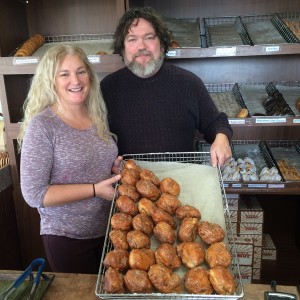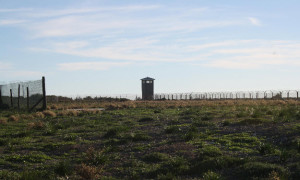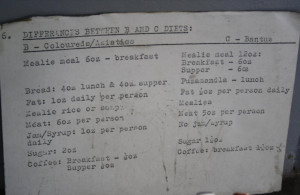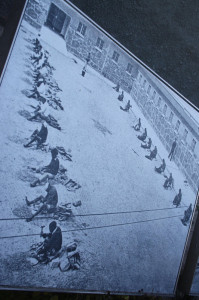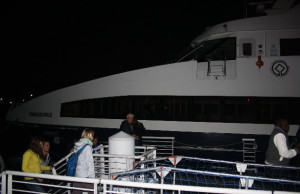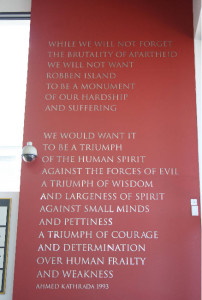Tag Archive
activity architecture art artist building Canada children city CostSaver downtown drive i-95 entertainment Europe event exhibit family festival Florida food fun historic History landmark local Museum music Nature New Zealand Ontario roadtrip sculpture Seattle show sights sightseeing tour tourist Trafalgar travel travelblogger view Washington Washington State water world
US: Mystic, CT – Mystic Garlic Festival – You Supply the Mints and They’ll Supply the Flavor
The 11th Annual Mystic Garlic Festival features freshly harvested local garlic, garlic infused goodies, music, and activities scattered throughout Olde Mistick Village.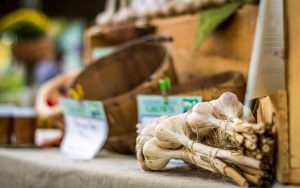
To celebrate the abundant fall harvest, farmers will present an amazing variety of Garlic for sale in addition to fresh produce. More farmers than ever will have honey, jams, preserves, ice cream, baked goods, and syrups.
Besides the proven health benefits of garlic, there is just something irresistible about the aroma of roasted garlic. Throughout the day and evening, dozens of local restaurants and food service establishments will be serving, for purchase, delicious garlic related foods, such as garlic fried dough and garlic fries, as well as non-garlic favorites.
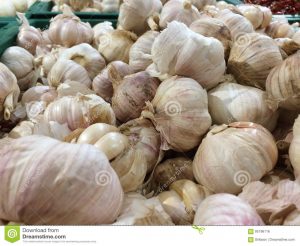 A host of merchants, artisans, authors and artists will line the pathways of Olde Mistick Village displaying their foods, crafts, gifts, and talents. Along with over 45 vendors, you will find Olde Mistick Village merchants offering garlic related activities or products at their stores.
A host of merchants, artisans, authors and artists will line the pathways of Olde Mistick Village displaying their foods, crafts, gifts, and talents. Along with over 45 vendors, you will find Olde Mistick Village merchants offering garlic related activities or products at their stores.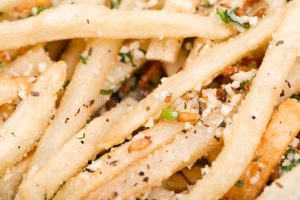
Don’t miss the live birds of prey, reptile show, and martial arts demonstration.
So, you bring the mints and Olde Mistick Village will supply the flavor. A great weekend of music, food, and family fun. Stroller friendly, Free entry and Free parking.
Location: Olde Mistick Village, 27 Coogan Blvd., Mystic, CT 06355
Date: Sept 15 – 16, 2018
Time: Sat 11am – 7pm, Sun 11am – 6pm
Tel: 860 -536-4941
oldemistickvillage.com
For Regional Accommodations, Restaurants & Attractions: thisismystic.com
Canada – Ontario Weekend Getaway: Low Fat Donuts, Fair Trade Coffee, Chainsaws and Friendly Alpacas
Why not get away with your family to Almonte, ON, just west of Ottawa . The very first reason is that Ed Atwell of Healthy Food Technologies (hft) has figured out how to make low-fat donuts that are scrumptious. He “tricks” the donuts by frying them (in zero trans fat oil) for 1/2 the time and then baking them at the same temperature. Watch the video to see him explain the process he invented.
Now take a walk around the corner and pick up your to-go-with coffee at fair trade high quality Equator Coffee Roasters. They roast the beans right there, having bought them from small-scale farming communities and paid the farmers well. Do not miss the Oh-so-Canadian maple-flavored latte. It’s worth driving there just for that! Kids can enjoy the hot chocolate.
Next you can pick up snacks for the car or yummies to take home at Dandelion Foods co-op before a 45 min. drive to Wheelers Pancake House and Maple Sugar Camp. D
andelion Foods co-op sells whole, local and organic foods and some for specialty diets. Here you can buy the famous Hummingbird chocolate bars favored by Prime Minister Trudeau. Note the PB & Joy (with peanut butter) and the spicy Mayan. Please bring back the Empire Cheese caramelized onion cheddar cheese for me.
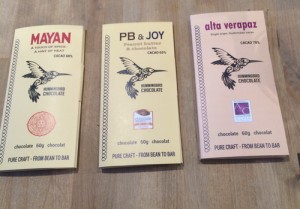
For lunch and fun, at Wheelers Pancake House you can visit the Maple Museum and the Chainsaw & Logging museum and the kids can have fun in the playground. Handy men and women will be mesmerized by Mark Wheeler’s dad Vernon’s collection of hundreds of chainsaws. Everyone will enjoy his “largest collection of pure maple syrup artifacts” which help explain the history of the maple sugar industry. From First Nations wooden spigots to the plastic lines of today, syrup pour-ers, molds, pails, and everything else related to this sweet topic, it’s all here at this 38-year family business. Don’t forget to leave room for the freshly made pancakes and delicious syrup right from their trees.
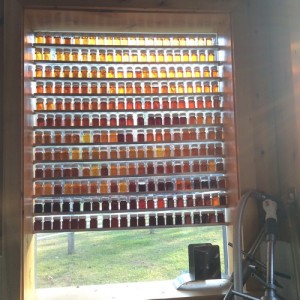
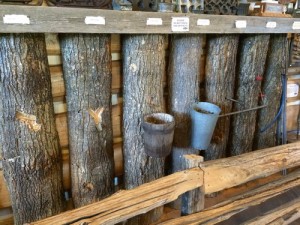
For the grand finale, we visited Keith and Elizabeth Adam’s alpacas and llamas at their Serendipity Farm. For retirement they decided to raise alpacas for the fun of it. The couple exudes their enjoyment of spending their golden years with these elegant, fluffy friends. They’ll chatter about the little quirks of each of the animals as well as the work associated with raising them.
Alpacas produce fiber that is as fine as cashmere, soft, silky and much warmer than sheep’s wool, while also wicking moisture away from the body.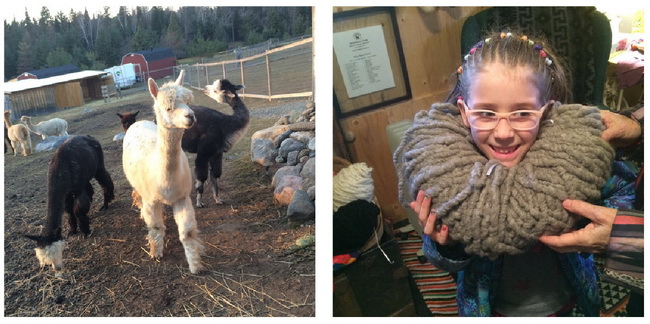
In their little shop you can buy scarves, gloves, purses, as well as fiber felted sheets, alpaca and fiber rovings and handspun yarn.
Leave some time too for the local shops which wind their way along the downtown streets. Yes there’s plenty to do in Lanark County for a low-key interesting getaway weekend. We are not sure how this area attracted so many hippie/free trade/entrepreneurial types who seem to care for the planet. You can feel virtuous spending time and money in this town.
Equator Coffee Roasters, 451-A Ottawa St, Almonte, ON K0A 1A0, Tel: 613-256-5960
www.equator.ca
Dandelion Foods, 541 Ottawa St, Almonte, ON K0A 1A0, Tel: 1-613-256-4545
www.dandelionfoods.ca
Healthy Food Technologies, 25 Industrial Rd., Almonte ON Tel: 613-256-9900
(HFT) https://www.facebook.com/HFTinc
Wheelers Pancake House and Maple Sugar Camp, 1001 Highland Line, McDonalds Corners(Lanark Highlands), ON K0G 1M0 Tel: 613-278-2090
www.wheelersmaple.com
Serendipity Farm Alpacas & Llamas, 929 South Lavant Rd, Lanark, ON K0G1K0 Tel: 613-259-3304 or 613-222-6303
www.serendipityalpacas.ca
South Africa: Visiting Robben Island, UNESCO World Heritage Site
By Adele Shapiro – March 2012.
As a child I used to visit Robben Island with my grandmother. Her son, my uncle, was a warder in the prison services there. The name “Robben”, despite sounding very English – is in fact the Dutch for “Seal” – and the name derives from the extensive seal colony that was found on the Island by the first Dutch settlers.
We would go to the Cape Town docks and from there, take a boat ride to the island, where we would spend the day with family. I was vaguely aware that there were bad people on the island, and that it was a prison…. but little did I know then of the role it was to play in South Africa’s later history. Years passed and now as an ad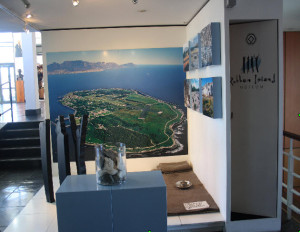 ult, I found myself revisiting the place where “the bad people” were kept, only now I realized that some were not so bad after all.
ult, I found myself revisiting the place where “the bad people” were kept, only now I realized that some were not so bad after all.
I bought a ticket for the tour some days before the trip, (advisable, as they fill up quickly) and took time out to examine the display at the Nelson Mandela Gateway at the V&A Waterfront in Cape Town.
There were many photographs of the political dissidents, the calls for boycotts, the anti-apartheid marches and there was also a prison cell that had been reconstructed for the purposes of the exhibit. I strongly recommend a visit to this exhibit before going to the island as it helps to contextualize the experience.
The trip began, as in times of old, with a boat ride from Cape Town docks, but this time instead of my uncle meeting us, we had a pleasant tour guide who told us jokes on our bus trip, whilst pointing out various sights on the island. Our bus was parked under a sign that said: “Welcome. We serve with pride.” I wondered if that sign had been there when Robben Island had been a prison as it was so sharply incongruous to the environment. I hoped not.
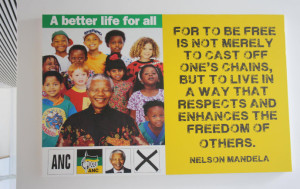 Robben Island has had a long history. First as a lighthouse to warn ships of the VOC, the Dutch East India Company (Verenigde Oostindische Compagnie), of the rocks that surround the island. But since the end of the 17th century, Robben Island has been used for the isolation of (mainly) political prisoners. The island was also used at various times as an animal quarantine station, a home for slaves, a leper colony, a hospital for the mentally ill and as a prison for French Vichy prisoners of war.
Robben Island has had a long history. First as a lighthouse to warn ships of the VOC, the Dutch East India Company (Verenigde Oostindische Compagnie), of the rocks that surround the island. But since the end of the 17th century, Robben Island has been used for the isolation of (mainly) political prisoners. The island was also used at various times as an animal quarantine station, a home for slaves, a leper colony, a hospital for the mentally ill and as a prison for French Vichy prisoners of war.
First we saw the Leper Graveyard and then house where Robert Sobukwe (Founder of the Pan Africanist Congress) had been kept separate from the other political dissidents.
It seems that Robert Sobukwe had special status in the prison. He was kept in solitary confinement at all times, but allowed certain privileges including access to books, being permitted to study, being permitted to wear civilian clothes, and being permitted bread. His children were allowed to visit him and they had their own bedroom in his “house”. Robert Sobukwe was convicted of incitement for demonstrating against and defying the Pass Laws, and in particular, for his connection to the PAC demonstration (although he was not present) which became known as the Sharpeville Massacre.
The notorious Pass Laws required black people to carry a pass book at all times when outside their compounds or designated areas, and were designed to limit severely the movements of the non-white population. This legislation was one of the dominant features of the country’s apartheid system.
Sobukwe was sentenced to three years in prison. After serving his sentence, he was moved to Robben Island for internment, as a new law called the General Law Amendment Act had been passed, which permitted his imprisonment to be renewed annually at the discretion of the Minister of Justice. This procedure became known as the “Sobukwe clause” and Robert Sobukwe was the only person whose imprisonment was extended under this clause. Imagine how special one has to be in order for parliament to pass a law just for you!
We also learned from our tour guide that the American politician and Pastor, Andrew Young, had fostered Sobukwe’s children in the USA, while Sobukwe had been in prison.
Our tour continued to the lime quarry where the political prisoners had worked. At the entrance to the quarry we saw a small cairn, and learned its history. In February 1995, (the landmark change of government was in 1994), about one thousand former political prisoners gathered again on Robben Island, but this time as free men, and to mark the occasion, each one placed a small stone from the quarry in a pile, making a small memorial to their years of hardship and struggle.
As we continued on our bus ride, we were shown a church, a hospital, a school and a mosque, and realized that far beyond our expectations, the island had supported a whole community. We duly arrived at the prison and tumbled out of the bus for our tour of “the real thing”. We were excited and filled with high spirits and I wondered for a moment where my heart would have been had I not been a tourist.
Inside we found grey walls. It was cool at midday; it was clear that at midnight it would be very cold. The communal cells were large and each had a bathroom attached.
Here we met our prison tour guide, Derrick Basson, a former political prisoner who served time on Robben Island for sabotage.
Derrick was very patient, humble and remarkably, not bitter. He answered all the insensitive questions calmly and without anger. In addition he explained the grading of the prisoners by race and also the diets that varied due to the racial classification of each prisoner. One of the curious facts he told us was that black prisoners were not given bread. As they were Africans their “natural” food was considered to be maize meal. The mixed race prisoners were allowed bread as they were considered to be more western or European and less African. The black Africans were also not allowed jam or syrup. I suppose you do not need jam if you have no bread.
Then I remembered that Robert Sobukwe, in spite of being black, was allowed to have bread, and it struck me that this must have been because he had been a university professor, and since this is a very “European” and non-tribal job, maybe he was considered eligible to receive bread.
Derrick further explained how prisoners slept on mats on the floor and how 5 blankets had not been enough to keep them warm at night. I suddenly remembered an interview with a former Alcatraz inmate who spoke of the extreme cold and of how prisoners had learned to sleep with only their elbows and knees touching the floor, hands locked behind the head. I became very grateful for my duvet.
We were told that in the beginning the political prisoners had been kept with the ordinary criminals, but later on, they were, thankfully, given their own “wing” and kept together. They came to call this place “The University” as they learned many things from each other and many of them also obtained degrees while in prison.
Derrick then took us to a yard where the prisoners had chopped rocks and turned them into stones, day after day in the sun. They were told that these rocks were used for roads built on the island, but no one seemed to know if this was true or not.
We were then taken to Nelson Mandela’s cell. Mandela was a militant anti-apartheid activist, as well as the co-founder and leader of the armed wing of the African National Congress (ANC), Umkhonto we Sizwe or “Spear of the Nation”. He was arrested in 1962 and convicted of sabotage, (amongst other charges), after he admitted to manufacturing explosives and acts of public violence, and was sentenced to life imprisonment. Mandela served 27 years in prison, 18 of these on Robben Island. After his release, he served as President of South Africa from 1994 to 1999.
My very first impression was of how small the cell was. No, not small, tiny. And then I thought that at least he could stand up and lie down in it, but not much more than that. At least it was larger than the dreadful box that I had heard was used in China. But there was no toilet. Just a metal bucket with a lid. At least a lid. And no tap, so no water. And if you are thirsty during the night, what should you do? And of course there was no electrical socket and no radio nor TV. And all I could think of was 27 years. TWENTY SEVEN YEARS! There was no door handle on the inside. The door was only operational from the outside, not unlike a cage. I remembered that Nelson Mandela had once remarked that the hardest and most traumatic experience he endured whilst on Robben Island for all those years was that he never ever saw, or even heard, a child. Can you imagine that? Now he insists on being photographed with children, whenever possible.
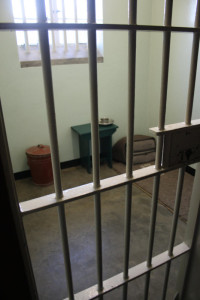 And then it was all over. We walked out to the yard, Derrick took us to the exit, and we said our goodbyes.I felt an odd mixture of elation and depression. Very happy that I had been to a UNESCO World Heritage Site of such importance, happier still that it was no longer a prison, and most happy that I was leaving. Yet also depressed and ashamed because of the suffering this place represented.
And then it was all over. We walked out to the yard, Derrick took us to the exit, and we said our goodbyes.I felt an odd mixture of elation and depression. Very happy that I had been to a UNESCO World Heritage Site of such importance, happier still that it was no longer a prison, and most happy that I was leaving. Yet also depressed and ashamed because of the suffering this place represented.
Duly subdued, we gratefully returned to our boat to ponder our feelings of inspiration and shock, enjoy the beautiful sunset cruise back to Cape Town, and watch a school of dolphins at play in the sea.
Remember when planning a visit to Robben Island, that the tours don’t always run on time. There was no snack bar on the boat. Our boat was 1 hour late in leaving Cape Town harbour and then we were rushed through our tour, which was a pity as there was too little time for questions.
A suggestion would be to make no appointments after the visit as the timing can vary, and also, take a snack pack. A sun hat and sun block are also good ideas.
Ferries depart (supposedly) at 9am, 11am, 1pm and 3pm, weather permitting, from Nelson Mandela Gateway, at the V&A Waterfront in Cape Town. Tickets costs are R230 for adults and R120 for children (U/18). Telephone: +27 (0)21 413 4200
Fax: +27 (0)21 419 1057
